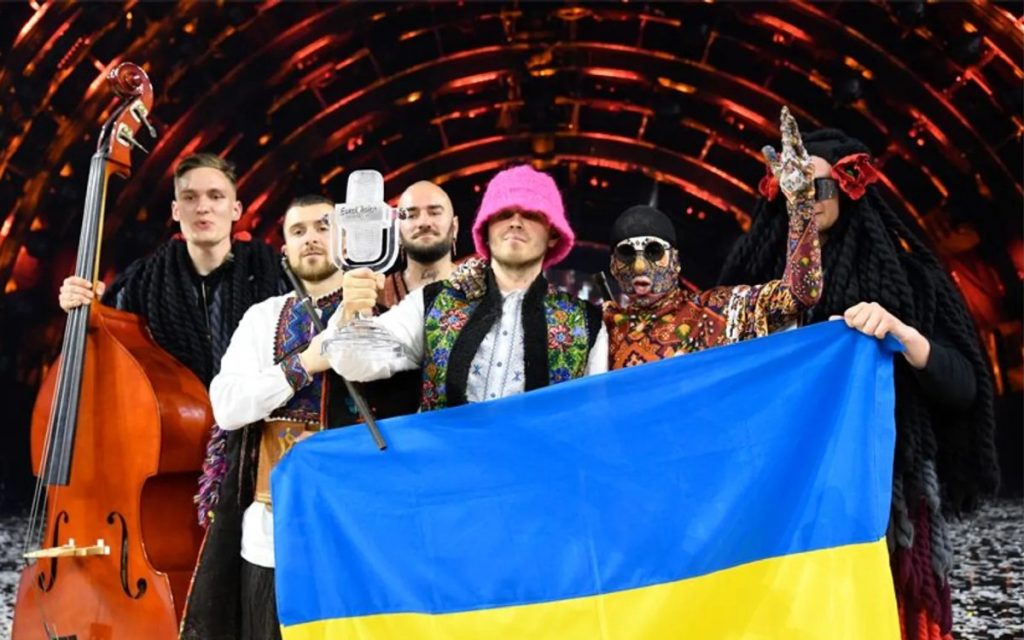Response to WAR

Ukraine’s Kalush Orchestra, this year’s winners of the Eurovision Song Contest, hardly had time to practice for their performance, which included acrobatic breakdancing while wearing traditional Vyshyvanka costumes. Instead, they served in the Ukrainian Territorial Defense Forces in the weeks preceding the tragedy. Their song Stefania, which combines hip-hop beats with traditional Ukrainian instruments, was the first rap and the first entirely Ukrainian music to ever win the competition. The song, which was a declaration of love for the lead singer’s mother, heavily incorporated the sounds of the sopilka and the telenka, two traditional Ukrainian woodwind instruments.
Ukrainian music is frequently first heard by foreign listeners during Eurovision, where a traditional-modern fusion and dramatic stage performance frequently appeal to audiences. All of the Ukrainian entries that have won the Eurovision competition have combined traditional musical components with historical narratives about the turbulent nation. With its chorus in Crimean Tatar, the 2016 winner, 1944 by Jamala, portrayed the tale of Stalin’s deportation of the Crimean Tatars from Crimea to Siberia. This tragedy took on new significance for Ukrainians after Russia claimed Crimea in 2014. The 2004 competition’s winner, Ruslana’s Wild Dances, played with clichés about the nation’s “wild women” by donning animal pelts and sampling trembita horns from the Carpathian mountains.
Eurovision is a major affair in Ukraine, and Ukrainians have always been big fans of the competition, says Dartsya Tarkovska, co-founder of Music Export Ukraine, an organization that promotes Ukrainian musicians overseas. Ruslana and Jamala, past winners, as well as songs that don’t even place, like Go A’s huge, trance-inspired Shum from 2021, have benefited greatly from it.

Former participant Tina Karol, who is currently traveling over Europe to collect money for Ukraine, tells BBC Culture: “Eurovision is so important as we can represent our country and culture, our sound. This year it was very sensitive for us to win. All our victories give us hope for winning the war.” Describing this year’s winning song Stefania as “really interesting” she adds, “pop and folk music were always close in Ukraine. Pop has always included our folk identity. We have different melodies and instruments than other countries – different scales for the voice, that make us very unique”.
Speaking to BBC Culture on the phone, Karol points out that “since the war has started everyone is even more proud to be Ukrainian, and they are only using Ukrainian language and folk melodies. It’s becoming more modern, new and popular. We want to show how beautiful our voices and melodies are. I’m really proud of our musicians. I’m sure that in the future only Ukrainian songs will exist in our country, no Russian songs.”
Jerry Heil, a Gen-Z “meme pop” phenomenon who has gained notoriety by combining fragments from popular memes from TikTok and other social media, has recently been on tour with Karol. Since Heil got his start on social media, he is aware of the influence it has had on both domestic and international efforts to support Ukraine.
Fans of Heil concur. Comments on one YouTube video read: “I currently serve in the armed forces. Thank you for the song, from the bottom of my heart.” On YouTube, several of her songs have thumbnails that feature the blue and yellow flag of Ukraine and text that describes the brutal realities of the war.
The 26-year-old Jerry Heil, who was born Yana Shemaieva, aspires for Ukrainian music to experience the same recent growth in popularity abroad as Latin music. She declares, “I truly believe that Ukrainian music is the next global trend,”.
While jumping over a bonfire is the customary way to mark Kupula night in Ukraine, Jerry is using her choir-girl falsetto voice to lead a group of Ukrainian refugee women in Berlin in a solemn prayer circle in the Chapel of Reconciliation. In order to meet Ukrainian refugee women and earn money to aid in the reconstruction of their nation, she is traveling throughout Europe. “There is definitely a sisterhood – when I’m travelling, I see women who are holding together and creating something. They’re creating new companies already to help other Ukrainian women. When they return they will bring this newfound experience back with them.”
Cultural fusion
Heil’s songs have evolved politically since the war. The An-225 Mriya, the largest aircraft in the world, is the subject of the stirring piano song Mriya, which features operatic harmonies. According to the Ukrainian foreign minister, Russian soldiers destroyed the An-225 Mriya during the pivotal struggle for the Antonov airport outside of Kyiv. The singer claims, “I realized it’s a strong metaphor. “I realised it’s a strong metaphor,” says the singer. “Because they can destroy the plane but they cannot destroy the dream or destroy our will.”
It’s all a far cry from when Heil first became famous. “I feel like I aged 20 years since the war started,” she says.She began out as a YouTuber and competed on X Factor Ukraine, but her career really took off when she published the catchy song Okrana Otmyena (Guard, Cancel), which is a song about a useless partner that uses the words “guard, cancel,” which is used when returning an item. In Ukraine, the expression was already a well-known joke.

Her most popular song since the war began is the ideal illustration of this; it expertly combines rap and pop while using a famous clip of the Ukrainian drag performer Verka Serdyuchka. Nesestry, Heil’s brand-new song, was created in collaboration with producer Vanyok Klymenko, who has previously worked with artists like alonya alonya and the Kalush Orchestra. The song, a reworking of the classic narrative-style Ukrainian ballad, also includes mother-singer vocals. “I thought that it could be a powerful feat,” says Heil. “Mother and daughter, two generations with a single dream.”
Ruslana recorded old folk music for Wild Dances, but it is common for pop performers in Ukraine to double as ethnomusicologists. They travel to isolated areas to record traditional folk music to blend with current songs. Heil usually merely samples and sings traditional harmonies. Under the Soviet Union, which sought to stifle Ukrainian folk culture and even went so far as to persecute and murder folk artists, this ethnomusicology was outlawed. According to ethnomusicologist Maria Sonevytsky, the Stalinist government executed thousands of bandura [a Ukrainian traditional instrument] musicians nationwide by the 1930s.
According to Christian Diemer, a musicologist who studies folk music and Ukrainian national identity, this fusion of traditional and modern music has flourished in Ukraine since the fall of the Soviet Union, spearheaded in particular by DakhaBrakham, the country’s equivalent of the German band Rammstein. One of the primary cultural characteristics that sets it apart from Russia, in his opinion, is this proud fusion of folk history and contemporary global music.
A law making Ukrainian the only official language was approved in 2019 and contained quotas of Ukrainian music on the radio. While Russian-language music previously predominated and pop performers were encouraged to sing in Russian to reach a wider audience, this has changed. According to analysis, the amount of Ukrainian-language music played on the radio has dramatically increased since 2016 and will reach up to 65% in the Western region of Lviv in 2020.
According to Diemer, this cultural preservation is a key method of resisting Russian imperialism. “The goal of the war is to destroy all of this. Russia wants to annihilate any notion of Ukrainian cultural identity, and national identity too. Culture plays an important role – the Russian leadership are saying this quite explicitly. They are using culture as a tool to achieve that end – by destroying museums, ethnographic collections, and by killing the carriers of culture and ‘Russifying’ the people under occupation. It’s at the core of the Russian agenda.”
The response from Ukraine makes sense. The distinctness of Ukrainian culture from Russia may be seen in everything from folk music to historical architecture to theater. Jerry Heil concurs and considers it her duty to promote Ukrainian culture outside of the nation. “We have been struggling for our culture for a long time, and it’s a miracle that this culture survived. If it’s that strong, then we have to show it to the world.”





Leave a Reply
You must be logged in to post a comment.